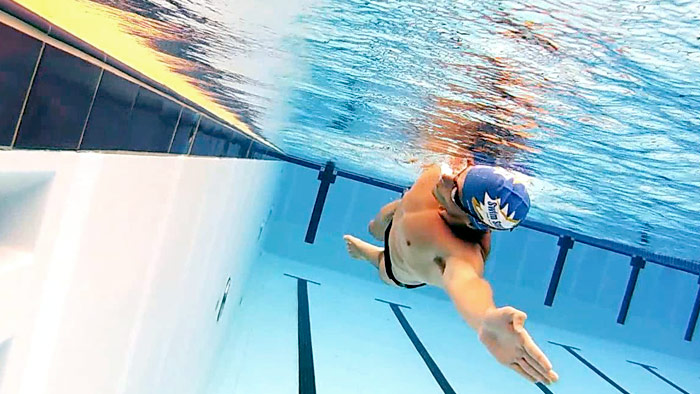The crossover is an extremely common swim technique problem and one of the most destructive in terms of speed. Worldwide swim coaching company Swim Smooth estimates that 70 percent of all their swim clinic attendees have a crossover.
What is a Crossover?
As your hand enters the water during front crawl, it should be perfectly in line with your shoulder. This helps you maintain a straight line and enables you to grab hold of the water and propel yourself forwards. During a crossover, one or both hands will cross the centre line as they enter the water. This affects your balance in the water and forces you to compensate in order to maintain a straight line.
Not only does this slow you down, but it is also increases your likelihood of making other related technique mistakes. If you can eliminate your crossover, the chances are you’ll improve several other aspects of your technique too.
Why Does it Slow You Down so Much?
A crossover impacts your ability to grab hold of the water and pull it backwards, reducing your propulsion. Swimmers with crossovers also attempt to regain balance by snaking their hips or doing a scissor kick, therefore creating more drag. While your legs are scissoring or snaking, it’s also harder to rotate your body to breath without losing propulsion. A crossover can also increase the risk of a shoulder injury, particularly if done in combination with a thumb-first hand entry.
Crossing over is a big problem even in open water, where there are no lane ropes or tiles to follow. Swimming straight is vital and it is not uncommon for athletes that crossover to swim ten percent further than necessary. In an IRONMAN triathlon, this could cost you five to nine minutes.
Three Ways to Fix Your Crossover
First up, you need to ascertain if you have a crossover. A friend or coach can check if you are crossing over the centreline in front of your head, even momentarily. Ask them to video you so you can check it yourself later on. If you are crossing over, make it your priority to fix it. There are three main ways you can do this.
1. Middle Finger Visualisation
Simply focus on your middle finger of each hand as it enters the water and extends forward. Imagine you’re pointing it down the barrel of a gun, straight towards the wall you’re swimming towards. Focus on the middle fingers and nothing else.
2. Use Swim Paddles
Swim paddles can enhance the feeling of a crossover and help you to make corrections. The Finis Freestyler paddle is especially good, as it’s designed for this purpose. It’s shaped like an arrow-head and it gives you immediate feedback on how straight your hands enter the water. In fact, they tend to fall off unless you get it right.
3. Kick on Your Side Drill/Swim Posture
In order to swim straight you need to establish a good swim posture. The kick on your side drill helps you to learn what it feels like to swim straight. The minute your lead-arm crosses the centre line you’ll notice yourself heading towards one side of the pool.
Put on a pair of fins, push off from the end of the pool, and bring yourself into a 90 degrees side-lying position. Kick at a steady pace and point your lower arm out in front of you. Rest your top arm by your side. Face downwards and exhale underwater while you’re kicking- this should feel like you’re looking past your armpit. To take a breath, simply turn your head, inhale, and return it to the water. Focus on bringing your shoulder blades down and together, as this encourages you to point your lead-arm straight. Focus on doing this when you return to normal front crawl too.
Now is a great time to focus on your technique, and putting in a few extra sessions that focus on eliminating this very common technique mistake. By eliminating your crossover you can improve your technique, avoid possible injury, and swim faster for the same energy.



